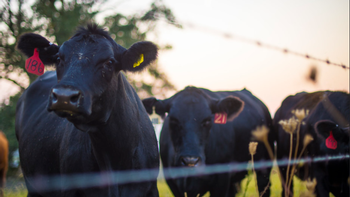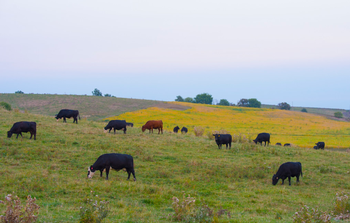What Are the Regulations for Grass Fed Beef
Overview All animal raising claims including, Grass-fed and Raised without the use of antibiotics need to be approved by the FSIS. 
In guild to sell beef with a label begetting an fauna raising claim the label must first be submitted to the Office of Policy and Program Evolution, Labeling and Program Delivery Staff (LPDS), in Food Saftey and Inspection Services (FSIS), and include all necessary documentation to support the special statement or merits. Examples of creature-raising claims include simply are non limited to: ''Vegetarian-fed,'' ''Grassfed,'' and ''Raised without the apply of antibiotics". To veiw specific documentation needed to file for a label through FSIS click here.
Grass-fed and Grass-finished
What is considered grass-fed?
In order to reduce the defoliation of grass-fed labels, in 2019 the USDA Nutrient Safety and Inspection Service issued new guidance for grass-fed beefiness labels. Beefiness can now merely be labeled as grass-fed if information technology received grass for 100% of its life, from weaning to harvest. In add-on, cattle must have admission to pasture before slaughter and cannot be confined. Nevertheless, if the products from animals have less than 100 percent access to grass or forage, the producer can even so use a partial "grass-fed" label as long every bit the consumer is informed about the proportion of the animal's diet coming from grain. For instance, a partial grass-fed label could be "Made from cows that are fed ninety% grass and 10% corn.''
Is grass-fed the same as grass-finished? Grass-fed is not the same as grass-finished 
According to the new FSIS labeling claims grass-finished is not the aforementioned every bit grass-fed. Grass-finished animals can receive grain during their lifetime opposed to grass-fed animals which cannot receive grain. Therefore, the characterization claim "Grain Fed, Grass Finished" would exist truthful and not misleading.
Is there a USDA grass-fed certification?
As of January 12, 2016, the Agricultural Marketing Service (AMS), a division of the US Department of Agriculture (USDA), withdrew their Grass- fed Marketing Merits for ruminant livestock (including cattle, lamb, caprine animal and buffalo) and whatever meat products derived from these animals. While there is currently no USDA grass-fed marketing merits, producers can nonetheless receive grass-fed certifications by obtaining their own label through the FSIS or through third parties.
How can I get my own grass-fed certification label?
Producers can file for a grass-fed labeling standard through the FSIS. For further instructions delight click here.
How tin I get my grass-fed certified through a third party?
Producers can also choose to obtain grass fed certification from an existing third party service. These include American Grassfed, the Food Alliance, and Animal Welfare Approved. Each of these organizations have specific standards for their label. Costs associated with third party labeling depends on the private organization. Below are links to third party grass-fed beef websites.
- American Grassfed,
- Nutrient Alliance
- Animate being Welfare Approved
Natural, Never-ever, and Organic
What is the USDA definition of natural?
According to the USDA "All fresh meat qualifies as "natural." Products labeled "natural" cannot contain any artificial flavor or flavoring, coloring ingredient, chemical preservative, or any other artificial or constructed ingredient; and the product and its ingredients are not more than minimally processed (ground, for case). All products claiming to be natural should be accompanied past a brief statement which explains what is meant by the term "natural." Information technology is important to note that natural claim does non include beast raising claims (i.east hormone free, raised without the use of antibiotics, 100% vegetarian, or grass-fed).
What does never-always mean, and is in that location a USDA never-e'er program?
The NE3 (Never-always 3) program was developed in 2009 as a bundled marketing merits and associated verification program to address a market need for livestock whose products would authorize for marketing claims of: 1. No Antibiotics administered; 2. No Hormones administered; and iii. No Fauna By-products fed at any point in the animate being's life. However, this USDA program was rescinded in 2015. Despite the retraction of this plan, many third-party labels (i.eastward. American Grassfed) accept antibiotic and hormone usage standards as function of their characterization claim. If a consumer is looking for products that have not received hormones or antibiotics for the time the animal was raised they should await for specific labels stating raised without antibiotics or hormones.
The official USDA Organic label 
According the the USDA, "USDA certified organic foods are grown and processed co-ordinate to federal guidelines addressing, among many factors, soil quality, fauna raising practices, pest and weed control, and utilize of additives. Organic producers rely on natural substances and physical, mechanical, or biologically based farming methods to the fullest extent possible".
Organic meat has additional organic standards and requires that animals are raised in living weather accommodating their natural behaviors (similar the ability to graze on pasture), fed 100% organic feed and forage, and not administered antibiotics or hormones.
Animal Welfare and GMO Labels
Is in that location a USDA label for animal welfare?
Animal raising claims related to how the creature is cared for how the relationship to how they are produced related to their environs are not defined by the FSIS in either regulations or policy guidelines. For animate being welfare claims, such as "Raised with Care," or environmental stewardship claims, such every bit "Sustainably Raised," FSIS will just approve a merits if a argument is provided on the label showing the proper name of the entity that established the standard and includes boosted terminology explaining the pregnant of the merits for consumers. As an culling, beast welfare and environmental stewardship claims can be certified by a third-political party certifying organization that posts the standards used to define the claim on its website.
1 of the larger third-political party labels that focuses on animal welfare is Certified Humane. For a listing of their standards please click here.
What is the non-GMO Label and how do I acquire ane?
The Not-GMO label is a third party label implemented by the Non-GMO Project. The Not-GMO projection have their ain set of industry standards which tin exist accessed here. For information regarding acquiring a Non-GMO Label click here.
Source: https://ucanr.edu/sites/nichemarketing/Niche_Market_Sheep_583/The_Who_What_and_Hows_of_Labels/
0 Response to "What Are the Regulations for Grass Fed Beef"
Post a Comment